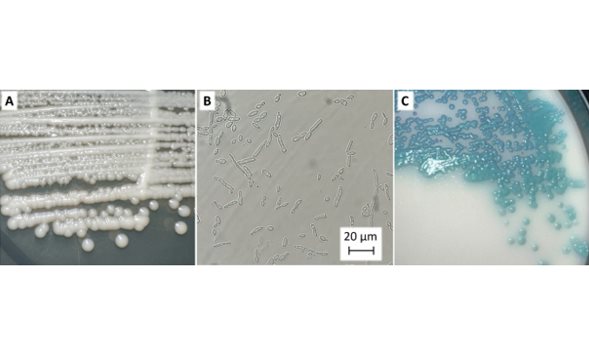
Researchers of the Radboudumc and CWZ Center of Expertise for Mycology and from the department of medical microbiology found and characterized a novel yeast species. This yeast caused bloodstream infections in patients from the USA, UK and Norway and was also found in sputum from patients in the Netherlands, including a patient from the Radboudumc. Unique characteristics of the novel species are the ability to grow beyond human body temperature, resistance to multiple antifungals and a slow growth in nutrient rich media. Furthermore, all isolates of this species are highly related to each other, suggesting a recent introduction in the human population. The characterization of this new species will aid in diagnostics and management of future infections. These findings were recently published in Infection.
While many fungal species are not causing human infections, an increasing number of species are reported as pathogens in the last two decades. This is partially due to improved diagnostics but the incidence of severe fungal disease is increasing. To investigate the genetic diversity in the rare yeast pathogen Candida blankii, we performed whole genome sequencing on a diverse collection of assumed C. blankii isolates. A few isolates were genetically closely related to each other but displayed substantial genetic differences in comparison to all other isolates. In addition, these isolates could not be identified with commonly used diagnostics in routine practice, i.e. the MALDI-TOF MS and ITS (Internal Transcribed Spacers) sequencing. Further characterization of the yeast demonstrated a remarkable relative slow growth compared to other common yeast species. This new species was named Tardiomyces depauwii, based on its slow growth rate (“tardio”), fungal kingdom (“myces”) and the nestor of medical mycology in the Netherlands (Ben de Pauw). Although infections appear quite rare, more research is warranted as species can rapidly emerge as occurred with Candida auris. Given that this and related species are often resistant to common antifungals, future investigations will focus on this characteristic.
T. depauwii morphology.
A Macroscopic morphology of T. depauwii after 48 h on YPD agar.
B Microscopic morphology of T. depauwii after 48 h in YPD broth.
C Morphology of T. depauwii on CandiSelect Agar.
Publication
Spruijtenburg B, de Souza Lima BJF, Granadillo Tosar ST, Borman AM, Torp Andersen C, Nizamuddin S, Ahmad S, de Almeida Junior JN, Aparecida Vicente V, Nosanchuk JD, Buil JB, de Hoog S, Meijer EFJ, Meis JF, de Groot T. The yeast genus Tardiomyces gen. nov. with one new species and two new combinations. Infection. 2024 Apr; doiL 10.1007/s15010-024-02229-6





